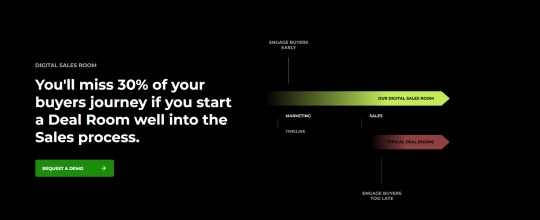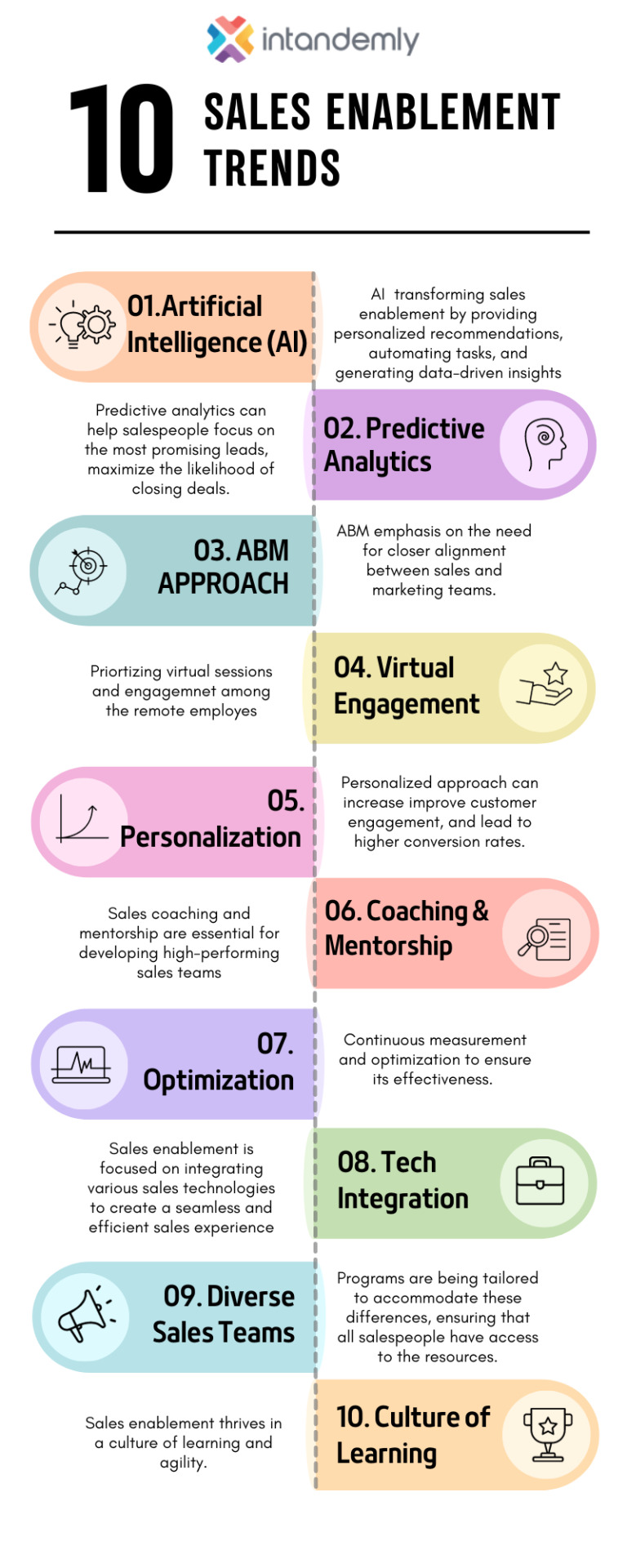#sales enablement software
Explore tagged Tumblr posts
Text
https://www.expeditecommerce.com/digital-sales-room

Engage buyers early with a digital sales room for both marketing and sales enablement. Accelerate deal conversion with real-time insights. Click here!
#digital sales room#digital sales room software#sales enablement software#sales enablement tools#sales enablement solutions#expeditecommerce#DSR
0 notes
Text
b2b lead generation and appointment setting services
Artificial Intelligence (AI) is an established concept that has gained significant traction in various areas of business management, marketing, and sales. One particular area where AI has made notable advancements is lead generation for B2B marketing. Many online lead-generation software options leverage AI technology to enhance and streamline the lead-generation process.
Artificial intelligence, in combination with lead generation software, harnesses the power of advanced platforms and algorithms. This powerful combination enables businesses to gather and analyze relevant data, leveraging past sales, marketing strategies, and market conditions. By doing so, it enhances customer relationship management, provides valuable insights for decision-making, and helps identify profitable investments, ultimately maximizing return on investment
Best Practices For B2B Appointment Setting List
Generating leads is imperative for a B2B company’s growth. One of the most effective ways to convert them is through appointment setting services. But just because it’s practical doesn’t mean it’s easy.
Creating and booking an appointment is a struggle in itself. Therefore, we will discuss the best practices for B2B appointment setting to be more productive, efficient, and thriving. So stay tuned and start reading!
Getting the data
Getting the data means prospecting. First, gather information about your prospects. Then, the salesperson will procure the prospect’s background information, industry sector, departments & personnel information, and contact information. Getting the information is directly linked to verifying the data.
Verifying the data
After gathering the data, you should verify the information. You can ascertain whether the prospect is qualified based on the collected information. This verification helps you prioritize and categorize the prospects.
Nowadays, various information about a person, like bio-data, social media accounts, and other account details, are collected online. This information can be natural or fake. Hence, verification of information is crucial. This verification process is done using prospecting and sales intelligence tools. Also, the gathering of prospects’ information is done using CRM tools and lead generation tools.
Research your prospect
You can schedule an appointment in advance. However, you need to understand your prospect before making an appointment. Prospects tend to ignore or hang up sale calls, and salespeople are least pleasant with cold calling. The salesperson communicates with different types of prospects and has to face objections and rejections.
Also Read: Proven Tips for Your Prospects Research
So, the salesperson must do homework about the prospect’s business and background. First, you must find their problem and whether your product/service solves it. Then, based on your imagined scenarios, the question-and-answer session assists the salesperson during appointments.
Understanding the pain points
Knowing your prospects’ pain points is essential for a successful sales meeting. Understanding what’s frustrating and keeping them up at night can tailor your pitch to address their needs. To determine your prospect’s pain points, you must research beforehand.
Talk to your customer service team, read reviews online, and ask your current customers about their experience with your product or service. Armed with this information, you’ll be ready to have a meaningful conversation with your prospects and show them that you’re invested in helping them solve their problem.
Do an outreach
In this step, you will try connecting with your prospect via different channels. These channels include mobile, email, and social media, also known as communication platforms. They are crucial for B2B appointment settings. You can use cadence or sequence to reach your prospect. Don’t try to follow templates or copy-paste the content for cadence or sequence.
You can develop innovative and engaging content to grab the attention of prospects. Two-way communication is vital because you can listen attentively, engage actively, and identify your prospect’s concern. Finally, create a lasting impression that makes your prospect look forward to the next appointment.
Make an online presence
Developing an impactful online presence is more critical than the prospecting process and creating network strategies. Salespersons can engage with prospects by following, commenting on, and liking their social media and other online accounts. This strategy helps them build a presence before their prospects and create a relationship with them.
The online presence helps you smooth out your work more than the first time you connect with them as a stranger. It is like a small but powerful action that allows you to lay the groundwork for booking an appointment with them.
#appointment setting#b2b lead generation#crm#lead magnet#booking software#sales enablement#sales leads
2 notes
·
View notes
Text
The Biggest Mistakes Companies Make When Hiring B2B Sales Talents
Hiring the right B2B sales talent is one of the most critical decisions a company can make. A skilled sales team can drive revenue, build strong client relationships, and contribute to business growth. However, making the wrong hiring choices can lead to lost opportunities, wasted resources, and high turnover rates.
Many companies unknowingly fall into common hiring pitfalls that prevent them from securing top sales talent. From focusing too much on industry experience to neglecting soft skills and cultural fit, these mistakes can significantly impact a company's sales success.
In this article, we'll explore the biggest hiring mistakes companies make when B2B sales recruiters professionals and how to avoid them.

1. Lack of a Clear Hiring Strategy
One of the biggest mistakes companies make is not having a well-defined hiring strategy. Many organizations rush the hiring process, hoping to fill vacant sales positions quickly without a structured approach. This leads to hiring candidates who may not be the best fit for the role.
A clear hiring strategy should include:
A detailed job description outlining responsibilities and expectations
A structured interview process with predefined evaluation criteria
A focus on long-term fit rather than just immediate sales performance
Without a solid hiring plan, companies risk hiring sales professionals who lack the skills, motivation, or cultural alignment needed for success. Taking the time to develop a strategic approach can prevent costly hiring mistakes.
2. Overemphasizing Industry Experience
Many companies mistakenly believe that hiring sales professionals with extensive industry experience is the key to success. While industry knowledge is valuable, it does not necessarily guarantee strong sales performance.
Sales skills such as persuasion, communication, and negotiation are often more important than prior industry experience. Candidates with a strong sales background but limited industry knowledge can quickly learn the specifics of a new field.
A balanced hiring approach should consider:
A candidate’s ability to learn and adapt
Proven sales success in previous roles
A mix of industry knowledge and transferable sales skills
Instead of solely focusing on past industry experience, companies should prioritize raw sales talent and potential.
3. Ignoring Soft Skills and Emotional Intelligence
B2B Sales Recruitment Agency are about building relationships, understanding customer needs, and communicating effectively. While technical knowledge and sales experience are important, soft skills and emotional intelligence (EQ) play an equally vital role in sales success.
Key soft skills to look for in B2B sales candidates include:
Active listening and empathy
Strong communication and interpersonal skills
The ability to handle rejection and stay resilient
Emotional intelligence helps sales professionals connect with prospects, navigate objections, and close deals. Companies that overlook these qualities may end up with sales reps who struggle to build meaningful client relationships.
4. Poorly Defined Sales Metrics and Goals
Without clear performance expectations, it’s difficult to hire and manage a successful sales team. Many companies fail to establish measurable goals and key performance indicators (KPIs) before hiring, leading to confusion and misaligned expectations.
Effective sales hiring should involve:
Setting clear revenue targets and quotas
Defining success metrics such as conversion rates and pipeline growth
Aligning compensation with performance goals
By clearly defining sales objectives, companies can attract candidates who understand expectations and are motivated to achieve results.
5. Relying Too Much on Resumes and Interviews
Traditional hiring methods, such as reviewing resumes and conducting interviews, do not always reveal a candidate’s true sales potential. A polished resume may highlight impressive achievements, but it doesn’t guarantee that a candidate can deliver results in a real-world sales environment.
Alternative evaluation methods include:
Role-playing exercises to test sales skills
Case studies and problem-solving scenarios
Trial sales projects or probationary periods
By incorporating practical assessments, companies can identify candidates who can truly excel in a B2B sales role.
6. Failing to Assess Cultural Fit
Cultural fit is often overlooked during the hiring process, yet it plays a crucial role in a salesperson’s success within a company. A sales candidate may have excellent skills and experience, but if they do not align with the company’s values, work environment, and team dynamics, they are less likely to thrive.
A poor cultural fit can lead to:
Lower job satisfaction and engagement
Increased turnover rates
Conflicts within the sales team
To assess cultural fit, companies should:
Clearly define their company values and work culture
Include behavioral interview questions to gauge alignment
Introduce candidates to potential teammates during the hiring process
Hiring sales professionals who align with the company’s culture improves collaboration and long-term retention.
7. Neglecting Continuous Training and Development
Another major mistake companies make is assuming that training ends after onboarding. The B2B Sales Training Companies are constantly evolving, and even the best sales professionals need ongoing development to stay ahead.
A lack of continuous training can result in:
Stagnant sales performance
Difficulty adapting to new market trends
Decreased motivation and engagement
Effective training programs should include:
Regular sales coaching and mentorship
Workshops on emerging sales techniques
Access to industry conferences and professional development resources
Investing in ongoing training keeps sales teams competitive and ensures long-term success.
8. Not Utilizing Data-Driven Hiring Practices
Many companies still rely on intuition when hiring sales talent instead of leveraging data-driven recruitment methods. While gut feeling can sometimes work, it often leads to bias and poor hiring decisions.
Data-driven hiring improves accuracy by:
Using AI-powered recruitment tools to analyze candidate potential
Tracking historical hiring trends to refine selection criteria
Assessing performance data from previous hires to identify success patterns
By integrating data into the hiring process, companies can reduce turnover and improve sales team performance.
9. Hiring Based on Gut Feeling Instead of Data
Even experienced hiring managers can fall into the trap of making decisions based on intuition rather than objective evaluation. This often leads to inconsistent hiring outcomes and a lack of predictability in sales performance.
Common biases that affect hiring include:
Confirmation bias – Favoring candidates who confirm preexisting beliefs
Halo effect – Overestimating a candidate’s abilities based on one strong trait
Similarity bias – Preferring candidates who resemble the interviewer
To avoid these biases, companies should:
Use structured interviews with standardized scoring
Implement skills assessments and role-specific tests
Gather feedback from multiple interviewers before making a decision
A more objective hiring approach leads to better results and a stronger sales team.
10. Underestimating the Importance of Onboarding
A strong onboarding process sets the foundation for a salesperson’s success. Unfortunately, many companies either rush through onboarding or lack a structured program, leading to poor performance and early turnover.
Common onboarding mistakes include:
Failing to provide clear product and market training
Overloading new hires with information too quickly
Not assigning mentors or sales coaches
An effective onboarding program should:
Last at least 60-90 days with a structured plan
Include hands-on sales training and role-playing exercises
Provide ongoing feedback and coaching
A well-designed onboarding experience ensures that new hires integrate smoothly and start delivering results faster.
11. Not Offering Competitive Compensation Packages
Top B2B sales professionals expect competitive salaries and incentives. Companies that offer below-market compensation packages risk losing top talent to competitors.
Common mistakes in sales compensation include:
Rigid salary structures with low commission potential
Unclear or overly complex bonus plans
Lack of performance-based incentives
To attract and retain top sales talent, companies should:
Offer a competitive base salary with uncapped commission opportunities
Provide clear and transparent bonus structures
Include additional perks such as stock options, travel incentives, or career development programs
A well-designed compensation plan motivates sales teams and boosts performance.
12. Failing to Evaluate Long-Term Potential
Many companies focus solely on immediate sales results rather than assessing a candidate’s long-term growth potential. Sales Recruitment Services Hiring for short-term needs can lead to high turnover and missed opportunities for internal promotions.
To identify long-term potential, companies should:
Look for candidates with leadership qualities
Assess a candidate’s ability to adapt to changing sales environments
Provide career development plans and growth opportunities
Hiring with the future in mind helps companies build strong sales teams with lasting impact.
13. Ignoring the Candidate Experience
The way companies handle the hiring process affects their reputation and ability to attract top talent. A negative candidate experience can discourage high-quality applicants from joining the company.
Signs of a poor candidate experience include:
Long and unorganized hiring processes
Lack of communication or delayed responses
Impersonal interviews that fail to engage candidates
To improve the candidate experience, companies should:
Streamline the hiring process with clear timelines
Maintain open and transparent communication
Provide feedback to all candidates, even those not selected
A positive candidate experience enhances employer branding and attracts top-tier sales professionals.
14. Not Leveraging Employee Referrals
Employee referrals are one of the most effective ways to find high-quality sales talent, yet many companies fail to utilize this hiring strategy. Employees often know strong candidates within their network who would be a good fit for the company.
Benefits of employee referrals include:
Faster hiring process and reduced recruitment costs
Higher-quality candidates with a proven track record
Improved cultural fit and team cohesion
To encourage referrals, companies should:
Offer referral bonuses or incentives
Make the referral process simple and accessible
Recognize and reward employees who refer successful hires
Leveraging internal networks can significantly improve hiring outcomes.
#sales#recruitment#sales recruitment#sales technology#sales enablement#sales consultant#sales techniques#sales training#sales management#sales consulting#salesforce#crm#sales crm#software crm#training#trending#viral#viral trends#viralpost
0 notes
Text
AI-Enabled Restaurant Management Solutions: Unleashing the Power of Data-Driven Decision Making
Over the last couple of years, AI-enabled Restaurant Management solutions have proved to be truly transformational in changing how restaurants operate and deliver their services. Such systems use artificial intelligence to empower the restaurateur with data-driven insights in smoothing restaurant operations and improving customer experiences for better efficiency. One of the recent innovations is voice AI ordering systems, drastically changing how order-and-pay happens in this space. How these technologies are taking the future of dining is discussed hereafter.
if you want to know more about Ai-enable restaurant management solution click the
0 notes
Text
#ai enabled restaurant management#restaurant pos system#online ordering system#restaurant point of sale#self service kiosk#full service restaurant#restaurant management software#quick service pos system#restaurant pos software#kitchen display system#restaurant management ecosystem
0 notes
Text
#sales operation#sales#revenue operations#crm#sales automation software#sales enablement#sales excellence#sales effectiveness
1 note
·
View note
Text

Sales enablement is a strategic, ongoing process that empowers sales teams with the content, guidance, and training they need to successfully engage buyers. It is a collaborative effort between sales, marketing, and other departments to ensure that sales teams have the tools and knowledge they need to sell effectively.
For more info: https://www.intandemly.com/sales-enablement-tools/
#b2b saas#b2bsales#small business#sales automation software#b2b lead generation#intandemly#account based marketing#sales#sales enablement
0 notes
Text
Elements of a Successful Sales Funnel
Want to boost your sales? Let's talk about the essential elements of a successful sales funnel page! 🛒💰
1. Awareness: The first step is to attract potential customers to your brand. Utilize social media, content marketing, and advertising to increase visibility and reach a wider audience. 📢
2. Interest: Once you have their attention, it's time to pique their interest. Provide valuable content, free resources, and engaging experiences to keep them engaged and wanting more. 💡
3. Desire: Now that they're interested, it's time to create a desire for your product or service. Highlight the benefits, solve their pain points, and show them why they need what you're offering. 💫
4. Action: The final step is to convert that desire into action. Make it easy for them to make a purchase or take the next step in the customer journey. Clear calls-to-action and a seamless purchasing process are crucial. 🛍️
Remember, a successful sales funnel is all about guiding potential customers through each stage of the buying process and ultimately converting them into loyal customers. 💸
Ready to learn more about creating your own sales funnel? Check out my ultimate sales funnel guide for beginners! 📈💼
#make money online#affiliate marketing#work from home#make money with affiliate marketing#online business#home business#digital marketing#marketing#online marketing#blogger#sales funnel marketing#sales funnel tips#sales funnel optimization#sales funnel#sales funnels#sales training#sales automation software#sales productivity#sales enablement#ecommerce#entrepreneur#startup#branding
1 note
·
View note
Text
Culinary Commerce: The Role of AI-Enabled Restaurants in Sales

Technology is playing a more and larger role in the constantly changing fabric of the culinary world, profoundly influencing our culinary adventures. The rise of culinary establishments with AI integration represents a ground-breaking and paradigm-shifting development in this field. These eating establishments use artificial intelligence's ability to advance both financial feats and the culinary the journey. In this essay, we set out on a fascinating journey into the universe of AI Enabled Restaurant and try to understand their enormous impact on the food industry.
Enhanced Cooking Skills in the Kitchen
The conduits in the kitchen are being carefully optimized by AI while being hidden from customers' sight. It ensures the most cost-effective use of the ingredients, avoiding waste. AI-driven kitchen automata manage the production of food with an unparalleled level of accuracy, consistency, and speed, hence reducing the length of time that customers must wait. This promptness not only results in cost-efficiency for the restaurant but also in the happiness of the customers.
Restaurants with AI-Enhanced Business Models
Revenue Maximization Using Data-Driven Cognition
Data is king in the world of food commerce. The power of data analytics can be utilized by restaurants with AI to gain profound understanding into customer behavior. They are more equipped to make intelligent decisions about pricing, menu changes, and marketing strategies since they can recognize the apex of dining traffic, beloved menu items, and seasonal vogues. This data-driven strategy helps restaurants increase sales and financial benefits since they are adept at making adjustments that are laser-focused on successfully meeting the needs of their customers.
Enhancing Patron Adherence
The ability to cultivate strong customer loyalty is one of the restaurants using AI as their main asset. Customers are more likely to return to the restaurant because of its cozy atmosphere of personalized menus and sleek service. AI also has the ability to provide specific customers personalized promos and incentives based on their preferences, thereby strengthening the relationship between the business and its customers. AI-assisted restaurants increase brand loyalty and contribute to the steady increase in financial entrance by creating an environment of exclusivity and attending to the unique needs of each customer
The Human Dimension
While AI is a crucial part of these organizations' successes, the importance of human interaction should not be underestimated. Staff who are friendly and attentive continue to be the foundation of any successful restaurant. AI just supports their efforts by optimizing processes and improving the eating experience.
The Future Route
AI-infused dining establishments are expected to spread further as the landscape of culinary commerce continues its continuous evolution. Customers are becoming more interested in dining experiences that offer them not only delicious meals but also a streamlined, tailored experience that meets their needs. It is projected that this development will increase AI's involvement in the restaurant industry.
In conclusion
AI-enhanced dining experiences with quick service POS system and represent a seismic shift in the culinary industry, redefining the eating experience while increasing efficiency and financial gain. These businesses are without a doubt ready to meet the constantly changing needs of the smart modern diner thanks to their use of artificial intelligence.
#Ai enabled restaurant#quick service POS system#restaurant management system#restaurant management software#restaurant management ecosystem#kitchen display system#kds system#full service restaurant#restaurant pos system#online ordering system#restaurant point of sale
0 notes
Text
TODO Sales CRM: Powering Your Business Success with Customer Relationship Management
In the dynamic world of business, where customers are at the center of every strategy, Customer Relationship Management (CRM) has become indispensable. TodoSales CRM stands out as a premier CRM solution, driving businesses towards success by building and nurturing customer relationships.
Understanding TodoSales CRM:
TodoSales CRM is a versatile and user-friendly software designed to empower businesses of all sizes to manage customer interactions effectively. It offers a comprehensive suite of tools and features that help streamline processes, enhance communication, and boost revenue.
Key Features of TodoSales CRM:
1. Effortless Data Management: TodoSales CRM simplifies the task of collecting, organizing, and accessing customer information. With a centralized database, it ensures that critical customer data is readily available for analysis and action.
2. Personalized Customer Engagement: The CRM system allows businesses to create personalized customer experiences. Leveraging data analytics, TodoSales CRM tailors marketing campaigns, product recommendations, and communication channels to cater to each customer's specific preferences and needs.
3. Seamless Communication: TodoSales CRM enables businesses to maintain timely and efficient communication with their customers. Whether it's sending targeted emails, automating follow-ups, or integrating with social media, it facilitates engaging with the audience effectively.
4. Sales Optimization: TodoSales CRM empowers sales teams with features for lead tracking, opportunity management, and visualizing the sales pipeline. This ensures that no sales opportunity is missed and that the sales process remains highly efficient.
5. Actionable Insights: The CRM system's data-driven approach provides actionable insights and reporting, helping businesses understand customer behavior, track performance, and fine-tune their strategies.
The TodoSales CRM Advantage:
- Enhanced Customer Satisfaction: TodoSales CRM allows businesses to deliver personalized solutions, resulting in improved customer satisfaction, loyalty, and retention.
- Revenue Growth: Personalized marketing and efficient sales processes lead to higher conversion rates and increased revenue.
- Operational Efficiency:** By automating repetitive tasks and streamlining operations, TodoSales CRM lets employees focus on building meaningful relationships with customers.
- Informed Decision-Making:** Data-driven insights empower businesses to make informed decisions, driving profitability and growth.
- Competitive Edge: Businesses utilizing TodoSales CRM gain a competitive advantage by staying ahead of competitors and adapting to evolving market conditions.
TodoSales CRM is more than just software; it's a strategic partner for businesses aiming to excel in today's customer-centric market. With its powerful features and commitment to helping businesses build strong customer relationships, TodoSales CRM is leading the way in enabling organizations to unlock their full potential and thrive in the digital age
#salesforce#crm software#marketing#software#branding#sales#success#business#employee tracking software#sales enablement#reporting and analytics
1 note
·
View note
Text
Sales CRM Software for Small Business, Manufacturing Industry - Cliky
Enhance customer interactions and boost sales with Cliky's powerful Customer Relationship Management (CRM) software. Best CRM and Automation for Small Business.
0 notes
Text

MiCLIENT can help sales teams increase their sales productivity by automating many of the tasks involved in the sales process. This can lead to improved bottom line results.
#sales#goingglobal#salesautomation#cpq#software#salesenablement
1 note
·
View note
Text
An open copyright casebook, featuring AI, Warhol and more

I'm coming to DEFCON! On Aug 9, I'm emceeing the EFF POKER TOURNAMENT (noon at the Horseshoe Poker Room), and appearing on the BRICKED AND ABANDONED panel (5PM, LVCC - L1 - HW1–11–01). On Aug 10, I'm giving a keynote called "DISENSHITTIFY OR DIE! How hackers can seize the means of computation and build a new, good internet that is hardened against our asshole bosses' insatiable horniness for enshittification" (noon, LVCC - L1 - HW1–11–01).

Few debates invite more uninformed commentary than "IP" – a loosely defined grab bag that regulates an ever-expaning sphere of our daily activities, despite the fact that almost no one, including senior executives in the entertainment industry, understands how it works.
Take reading a book. If the book arrives between two covers in the form of ink sprayed on compressed vegetable pulp, you don't need to understand the first thing about copyright to read it. But if that book arrives as a stream of bits in an app, those bits are just the thinnest scrim of scum atop a terminally polluted ocean of legalese.
At the bottom layer: the license "agreement" for your device itself – thousands of words of nonsense that bind you not to replace its software with another vendor's code, to use the company's own service depots, etc etc. This garbage novella of legalese implicates trademark law, copyright, patent, and "paracopyrights" like the anticircumvention rule defined by Section 1201 of the DMCA:
https://www.eff.org/press/releases/eff-lawsuit-takes-dmca-section-1201-research-and-technology-restrictions-violate
Then there's the store that sold you the ebook: it has its own soporific, cod-legalese nonsense that you must parse; this can be longer than the book itself, and it has been exquisitely designed by the world's best-paid, best-trained lawyer to liquefy the brains of anyone who attempts to read it. Nothing will save you once your brains start leaking out of the corners of your eyes, your nostrils and your ears – not even converting the text to a brilliant graphic novel:
https://memex.craphound.com/2017/03/03/terms-and-conditions-the-bloviating-cruft-of-the-itunes-eula-combined-with-extraordinary-comic-book-mashups/
Even having Bob Dylan sing these terms will not help you grasp them:
https://pluralistic.net/2020/10/25/musical-chairs/#subterranean-termsick-blues
The copyright nonsense that accompanies an ebook transcends mere Newtonian physics – it exists in a state of quantum superposition. For you, the buyer, the copyright nonsense appears as a license, which allows the seller to add terms and conditions that would be invalidated if the transaction were a conventional sale. But for the author who wrote that book, the copyright nonsense insists that what has taken place is a sale (which pays a 25% royalty) and not a license (a 50% revenue-share). Truly, only a being capable of surviving after being smeared across the multiverse can hope to embody these two states of being simultaneously:
https://pluralistic.net/2022/06/21/early-adopters/#heads-i-win
But the challenge isn't over yet. Once you have grasped the permissions and restrictions placed upon you by your device and the app that sold you the ebook, you still must brave the publisher's license terms for the ebook – the final boss that you must overcome with your last hit point and after you've burned all your magical items.
This is by no means unique to reading a book. This bites us on the job, too, at every level. The McDonald's employee who uses a third-party tool to diagnose the problems with the McFlurry machine is using a gadget whose mere existence constitutes a jailable felony:
https://pluralistic.net/2021/04/20/euthanize-rentier-enablers/#cold-war
Meanwhile, every single biotech researcher is secretly violating the patents that cover the entire suite of basic biotech procedures and techniques. Biotechnicians have a folk-belief in "patent fair use," a thing that doesn't exist, because they can't imagine that patent law would be so obnoxious as to make basic science into a legal minefield.
IP is a perfect storm: it touches everything we do, and no one understands it.
Or rather, almost no one understands it. A small coterie of lawyers have a perfectly fine grasp of IP law, but most of those lawyers are (very well!) paid to figure out how to use IP law to screw you over. But not every skilled IP lawyer is the enemy: a handful of brave freedom fighters, mostly working for nonprofits and universities, constitute a resistance against the creep of IP into every corner of our lives.
Two of my favorite IP freedom fighters are Jennifer Jenkins and James Boyle, who run the Duke Center for the Public Domain. They are a dynamic duo, world leading demystifiers of copyright and other esoterica. They are the creators of a pair of stunningly good, belly-achingly funny, and extremely informative graphic novels on the subject, starting with the 2008 Bound By Law, about fair use and film-making:
https://www.dukeupress.edu/Bound-by-Law/
And then the followup, THEFT! A History of Music:
https://web.law.duke.edu/musiccomic/
Both of which are open access – that is to say, free to download and share (you can also get handsome bound print editions made of real ink sprayed on real vegetable pulp!).
Beyond these books, Jenkins and Boyle publish the annual public domain roundups, cataloging the materials entering the public domain each January 1 (during the long interregnum when nothing entered the public domain, thanks to the Sonny Bono Copyright Extension Act, they published annual roundups of all the material that should be entering the public domain):
https://pluralistic.net/2023/12/20/em-oh-you-ess-ee/#sexytimes
This year saw Mickey Mouse entering the public domain, and Jenkins used that happy occasion as a springboard for a masterclass in copyright and trademark:
https://pluralistic.net/2023/12/15/mouse-liberation-front/#free-mickey
But for all that Jenkins and Boyle are law explainers, they are also law professors and as such, they are deeply engaged with minting of new lawyers. This is a hard job: it takes a lot of work to become a lawyer.
It also takes a lot of money to become a lawyer. Not only do law-schools charge nosebleed tuition, but the standard texts set by law-schools are eye-wateringly expensive. Boyle and Jenkins have no say over tuitions, but they have made a serious dent in the cost of those textbooks. A decade ago, the pair launched the first open IP law casebook: a free, superior alternative to the $160 standard text used to train every IP lawyer:
https://web.archive.org/web/20140923104648/https://web.law.duke.edu/cspd/openip/
But IP law is a moving target: it is devouring the world. Accordingly, the pair have produced new editions every couple of years, guaranteeing that their free IP law casebook isn't just the best text on the subject, it's also the most up-to-date. This week, they published the sixth edition:
https://web.law.duke.edu/cspd/openip/
The sixth edition of Intellectual Property: Law & the Information Society – Cases & Materials; An Open Casebook adds sections on the current legal controversies about AI, and analyzes blockbuster (and batshit) recent Supreme Court rulings like Vidal v Elster, Warhol v Goldsmith, and Jack Daniels v VIP Products. I'm also delighted that they chose to incorporate some of my essays on enshittification (did you know that my Pluralistic.net newsletter is licensed CC Attribution, meaning that you can reprint and even sell it without asking me?).
(On the subject of Creative Commons: Boyle helped found Creative Commons!)
Ten years ago, the Boyle/Jenkins open casebook kicked off a revolution in legal education, inspiring many legals scholars to create their own open legal resources. Today, many of the best legal texts are free (as in speech) and free (as in beer). Whether you want to learn about trademark, copyright, patents, information law or more, there's an open casebook for you:
https://pluralistic.net/2021/08/14/angels-and-demons/#owning-culture
The open access textbook movement is a stark contrast with the world of traditional textbooks, where a cartel of academic publishers are subjecting students to the scammiest gambits imaginable, like "inclusive access," which has raised the price of textbooks by 1,000%:
https://pluralistic.net/2021/10/07/markets-in-everything/#textbook-abuses
Meanwhile, Jenkins and Boyle keep working on this essential reference. The next time you're tempted to make a definitive statement about what IP permits – or prohibits – do yourself (and the world) a favor, and look it up. It won't cost you a cent, and I promise you you'll learn something.

Support me this summer on the Clarion Write-A-Thon and help raise money for the Clarion Science Fiction and Fantasy Writers' Workshop!

If you'd like an essay-formatted version of this post to read or share, here's a link to it on pluralistic.net, my surveillance-free, ad-free, tracker-free blog:
https://pluralistic.net/2024/07/30/open-and-shut-casebook/#stop-confusing-the-issue-with-relevant-facts

Image: Cryteria (modified) Jenkins and Boyle https://web.law.duke.edu/musiccomic/
CC BY-NC-SA 4.0 https://creativecommons.org/licenses/by-nc-sa/4.0/
#pluralistic#jennifer jenkins#james boyle#ip#law#law school#publishing#open access#scholarship#casebooks#copyright#copyfight#gen ai#ai#warhol
182 notes
·
View notes
Text
Transform Your Restaurant with Voice AI Food Ordering
As technology continues to shape the dining experience, voice AI food ordering is revolutionizing how customers interact with restaurants. With eatOS’s AI-enabled ordering automation, restaurants can now offer a seamless, efficient, and innovative way for guests to place orders using voice commands.
This cutting-edge system allows customers to speak directly to an AI-powered assistant, simplifying the ordering process. Whether guests are dining in or ordering for delivery, voice AI food ordering ensures quicker, more accurate order placements. It eliminates the need for waitstaff to take orders manually, reducing human error and speeding up service.
For restaurants, this technology not only improves customer satisfaction but also enhances operational efficiency. The AI-enabled system integrates directly with your POS and kitchen systems, ensuring that orders are sent directly to the kitchen without delay. By automating routine tasks like order-taking, your staff can focus more on delivering an exceptional dining experience.
With eatOS’s voice AI food ordering solution, restaurants can stay ahead of the curve and meet the growing demand for modern, contactless service. Discover how this innovative technology can elevate your restaurant by visiting eatOS AI-Enabled Ordering Automation.
#voice AI food ordering#AI-enabled ordering automation#articifial intelligence#technology#point of sale software
0 notes
Text







At the other end of the table Helene gives a gentle laugh and spears a glistening piece of steak with her fork. Tom takes a long drink from his beer glass, as if toasting his own wit. Connor sets his fork down on his plate. Saffron tries to make eye contact with him but he is staring at the wooden salt and pepper shakers, his jaw clenched.
“That's not true at all,” Saffron says to Tom. "Why would you even say that?"
“Saff, it's okay," says Connor. “Dad just thinks he's being funny. Don't worry about it."
“All I'm trying to say is that Helene and I are exceedingly grateful to you for all you've done for Connor this term," says Tom. He bestows his shark-like smile upon her once again, but she doesn't smile back. “I meant academically, but I’m sure you’ve helped him in myriad other ways as well. We’ve noticed a lot of positive changes, haven’t we Helene?"
“Oh, definitely,” says Helene.
“What are you talking about? You wouldn't notice if I grew two heads,” says Connor.
“Watch the attitude, son,” says Tom. His tone is pleasant, and sends a small shiver down Saffron's spine.
“I'm glad to hear that you think I'm a positive influence, because I was paranoid you'd think I was a bad influence after I made Connor skip school with me the other day," says Saffron. Tom looks at her blankly, his eyebrows raised.
“I didn’t hear anything about this,” says Tom. “Did you, Hel?”
“I think I may have received a voicemail or an email from the school, now that you mention it,” Helene says. “I probably just assumed it was a message asking me to donate to the second-hand uniform sale or something.”
“Wow," says Saffron. “My mother went off her head.”
“Saffron’s mother is a police officer,” Helene tells Tom, as if this is the sole explanation for her reaction.
“Ah,” says Tom. “And what does your father do, Saffron?”
“Here we go,” mutters Connor.
“He operates a chain of childcare centres,” says Saffron.
“Really,” says Helene. “What's the name of his business?”
“Little Sprouts,” says Saffron. Both Helene and Tom make noises signifying their recognition and approval.
“Oh, I’ve heard they’re doing very well!” Helene says. “Didn’t he just open several more centres?”
“Yeah, he’s got five now,” says Saffron.
“Does he use an accountancy firm?” says Tom. Connor mutters something under his breath.
“I think Mireille- his girlfriend- does all the accounting,” says Saffron.
“There’s a wise saying that I like to tell my clients, Saffron,” says Tom. “And that saying is: 'It’s not the money that matters, it’s how you use it that determines its true value'.”
He pauses for effect.
“Woah. Interesting,” Saffron deadpans while Connor stifles a loud yawn. Helene narrows her eyes at him.
“Now, I’m sure your Dad’s girlfriend is more than competent in the area of bookkeeping and handling the payroll and the rest of the basics, but how up to date is she with the latest tax laws?” says Tom. “Does she know how to forecast cash flow? Does she realise the importance of accurate record keeping? Does she have access to the most up-to-date accounting software, which will enable she and your father to maximise business efficiency and productivity?”
"I have no idea," says Saffron sweetly. "But I'm guessing you do, right?"
99 notes
·
View notes